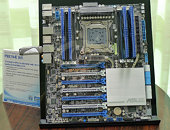Wednesday, January 9th 2013

ASUS P9X79-E WS Detailed
It looks like the void left by lack of socket LGA1150 motherboards is being filled by new LGA2011 HEDT ones, with ASUS joining in with the P9X79-E WS. The board is so big and feature-packed that its designers labeled it a workstation board that's built in the SSI-CEB form-factor (should fit in full-ATX cases that have room for EATX). The board features a 10-phase CPU VRM, seven PCI-Express 3.0 x16 slots, which are wired to the CPU through a couple of 48-lane PCI-Express bridge chips, support for 128 GB quad-channel DDR3 memory, six SATA 6 Gb/s ports (two from the X79 PCH, four from third-party controllers), four SATA 3 Gb/s ports, a couple of eSATA 6 Gb/s ports, four USB 3.0 ports, FireWire, 8-channel HD audio, and two gigabit Ethernet interfaces, which are each backed by Intel-made PHYs.
Source:
VR-Zone

23 Comments on ASUS P9X79-E WS Detailed
That motherboard is crowded. Looks impressive.
Sorry, had to say it. Socket 1155 doesn't even have the hardware to link multiple CPUs on one board (only 2011 has that ability currently). If the hardware doesn't support it, you're not likely to see it in consumer level boards.
but I am with you bro,... us Asus P9X79 Deluxe users need to stick together,.... ;)
Asus *could* make a dual socket board if they wanted to, but their rebel streak fizzled out long ago.
Unfortunately or fortunately depending on how one looks at it, I'm kinda low on the upgrade stack at the moment. Kid #2 is older now, going to get the wife's old computer and she'll get a new one. I'll be getting a new GPU/monitor so that my current ones trickle down.
I won't be getting new core hardware until... oh, look at that... when the Ivy Bridge-E chips are slated to be released :D
It's not just the number of phases that is important, but how much current each phase can supply.
This all on a Rampage IV Extreme, I think it has even less than 20 phases, what matters is the quality of the phases IMHO.
I've seen upwards of 400W on this chip with 1.55v+ btw :p
However, on ASRock Fatal1ty Champion and X79 Extreme11, I can run 5.0 GHz @ 1.4 V on my 3960X, aircooled. P9X79 Deluxe, 1.4 V won't even get 4.6 GHz fully stable. 400+ Mhz is pretty big.
Forget about it on any other brand boards, they are just the same as the P9X79 Deluxe. What ASRock really does different I am not sure, but what I can say is that to my eyes, ASRock does have a far beefier VRM, on the Extreme11, 1000% for sure it's got the best VRM out of all boards I have tried.
ASUS neglected to send me ROG X79 boards, so I have no idea how well they work.
So, I hope that the same is not an issue on this WS board, but since it IS a WorkStation product, I do not really expect CPU clocking to be a top priority, and stability will be the key point.